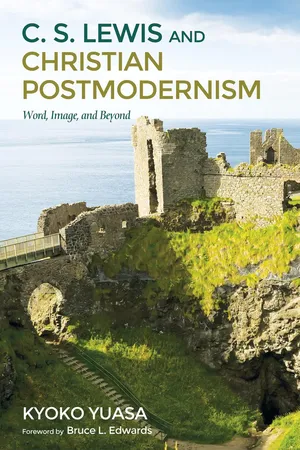![]()
1
Philosopher of Christian Postmodernism
C.S. Lewis accepts the conflicting values of realism and supernaturalism, but ultimately reaches an understanding which exceeds both views. The philosophical stance of accepting this dichotomy is in direct opposition to the spirit of his modernistic age, which prefers to divide realism and supernaturalism, highlighting either thought or a singular point of view. He advocates not the conflicts but the harmony of the contrasting values of the natural and the supernatural. He claims that we have no reason to vie for superiority by regarding “the one or the other as inferior.” He finds it illogical for the modernist to insist on looking inside the mathematician’s brain to find “timeless and spaceless truths about quantity.” An analysis of Lewis’s concept of modernism will conversely reveal that he shares a postmodernist sensibility, in the sense that he is suspicious of the modern theorists who claim a superiority of realism to supernaturalism or insist on either aspect of worldviews, realism and supernaturalism, and that Lewis contributes to the reconciliation of worldviews divided by modernistic beliefs. As to Lewis’s trust in the ability of language, Bruce Edwards states that a growing number of scholars (including philosopher John Beversluis) try to rehabilitate Lewis above contemporary charge. He thinks that although Lewis is an insightful guide for literary criticism, “his name will not be listed among the first rank of critics contemporary with him—men like T.S. Eliot or F.R. Leavis.” But Lewis’s anti-modernistic argument has spurred and inspired discussion amongst scholars of interdisciplinary fields, not only in literature but also in theology and science, in the twentieth and twenty-first centuries. The negative response from the modernist critic and the positive feedback from the different disciplines, theological and scientific, regard him as an anti-modernist. The discussion of him as an anti-modernist will reversely reveal that he is a writer of Christian postmodernism, contributing to a reconciliation of conflicts between realism and supernaturalism.
Modernism and Postmodernism
The difficulties of defining modernism and postmodernism have been indicated by a number of critics, including Matei Calinescu, Brian McHale, Michael Bell, Stanley J. Grenz, Louis Markos, and Crystal Downing. All of these critics assume modernism as the background against which to define postmodernism, even though each has a different emphasis. Calinescu emphasizes the continuity between modernism and postmodernism; McHale claims that the two concepts begin with clash but finish in a circle; Bell reviews the two notions as different stages of the same metaphysic; Grenz observes a shift from the modern era of manufacturing “goods” to the postmodern period of manufacturing “information”; Markos views modernism as “the bottom to top paradigm,” counter to the traditional paradigm in which human thought is a divine gift (top to bottom); and Crystal Downing welcomes postmodernism which works to undermine modernist foundations.
Matei Calinescu historically clarifies the changing relation between modernism and Christianity. In Five Faces of Modernity: Modernism, Avant-Garde, Decadence, Kitsch, Postmodernism (1987), he analyzes the historical shift of ideas of modernity, changing from non-religious notions (the Renaissance period) to religious conflicts against Christianity (modern time), in four phases: the Middle Ages, the Renaissance, the Romantic period, and the modern times.
Calinescu points to the difficulty of defining modernism, as its thought appears to be paradoxical: it advocates the death of God, while preserving its positive imagination of Christianity. The term becomes associated with both “unbeliever” and “a free-thinker.” He also finds a paradox between modernism and romanticism. The Romantic period shares a modern feeling of a dying God, as well as the anti-modern sensibility that integrates mythology and Christianity. He concludes that modernity is a concept that changed from non-religious to religious at the beginning of the twentieth century.
Michael Bell also finds it hard to date the emergence of modernity, but broadly outlines modernism as having peaked between 1910 and 1925, and argues that its intellectual formation is associated with lines of thought that include Marx, Freud, and Nietzsche. In “The Metaphysics of Modernism” (2011), Bell defines modernism as the age of “relativistic consciousness,” describing the ethos of relativism with the term “the world picture,” borrowed from Martin Heidegger. The twentieth century philosopher Heidegger characterizes the relativistic consciousness of modernity with the well-known phrase “the world becomes picture.”
Brian McHale concludes that the dominant of postmodernism is not singular, but plural. He bases his conclusion of dominant on Roman Jakobson’s definition of dominant. Jakobson views the dominants as the components of a work of art which rule the remaining components. McHale proposes that the dominant of modernist fiction is epistemological, which deploys strategies on how to know the world, while the dominant of postmodernist fiction is ontological, which deploys strategies based on which world you are in. He asserts that text depends on different dominants, historical and cultural.
Stanley J. Grenz observes the postmodern ethos expanding as a cultural phenomenon between 1960 and 1990. He states that the term “postmodernism” was first used in the 1930s by Spanish writer Federico de Onis and h...
